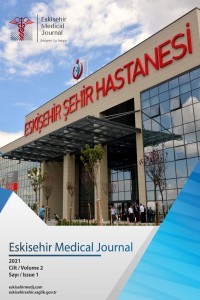ATEROJENİK İNDEX İLE SABAH KAN BASINCI DALGALANMASI ARASINDAKİ İLİŞKİ
morning surge blood pressure, plasma atherogenicity index, cardiovascular diseases
THE RELATIONSHIP OF MORNING SURGE in BLOOD PRESSURE and ATHEROGENIC INDEX
___
- 1- Mendis S, Davis S, Norrving B. Organizational update: the world health organization global status report on noncommunicable diseases 2014; one more landmark step in the combat against stroke and vascular disease. Stroke. 2015;46:e121-2.
- 2- Virani SS, Alonso A, Aparicio HJ, et al. Heart Disease and Stroke Statistics-2021 update: a report from the American Heart Association. Circulation.2021;143:e254– 743.
- 3- Kario K. Morning surge in blood pressure and cardiovascular risk: evidence and perspectives. Hypertension. 2010; 56:765–73.
- 4- Metoki H, Ohkubo T, Kikuya M, et al. Prognostic significance for stroke of a morning pressor surge and a nocturnal blood pressure decline: the Ohasama study. Hypertension. 2006; 47:149–54.
- 5- Li Y, Thijs L, Hansen TW, et al; International Database on Ambulatory Blood Pressure Monitoring in Relation to Cardiovascular Outcomes Investigators. Prognostic value of the morning blood pressure surge in 5645 subjects from 8 populations. Hypertension. 2010; 55:1040–48.
- 6- Dobiásová M, Frohlich J. The plasma parameter log (TG/ HDL-C) as an atherogenic index: Correlation with lipoprotein particle size and esterification rate in apoB-lipoproteindepleted plasma (FER (HDL)). Clinical Biochemistry. 2001;34:583-88.
- 7- Fernández-Macías JC, Ochoa-Martínez AC, Varela-Silva JA, Pérez-Maldonado IN. Atherogenic Index of Plasma: Novel Predictive Biomarker for Cardiovascular Illnesses. Archives of Medical Research. 2019;50:285-94.
- 8- Won KB, Jang MH, Park EJ, et al. Atherogenic index of plasma and the risk of advanced subclinical coronary artery disease beyond traditional risk factors: An observational cohort study. Clinical Cardiology. 2020;43:1398-04.
- 9- Hengel FE, Sommer C, Wenzel U. Arterielle Hypertonie. Eine Übersicht für den ärztlichen Alltag [Arterial Hypertension]. Dtsch Med Wochenschr. 2022;147:414-28.
- 10- Bhardwaj S, Bhattacharjee J, Bhatnagar MK, Tyagi S. Atherogenic index of plasma, Castelli risk index and atherogenic coefficient- new parameters in assessing cardiovascular risk. Internatıonal Journal Of Pharmacy And Bıologıcal Scıences. 2013;3:359–64.
- 11- Millán J, Pintó X, Muñoz A, et al. Lipoprotein ratios: Physiological significance and clinical usefulness in cardiovascular prevention. Vascular Health and Risk Management. 2009;5:757–65.
- 12- Ginsberg, HN. New perspectives on atherogenesis: Role of abnormal triglyceride-rich lipoprotein metabolism. Circulation. 2002;106:2137–42
- 13- Rye KA, Bursill CA, Lambert G, Tabet F, Barter PJ. The metabolism and anti-atherogenic properties of HDL. Journal of Lipids Research. 2009;50 Suppl:S195-200.
- 14- Won KB, Jang MH, Park EJ, et al. Atherogenic index of plasma and the risk of advanced subclinical coronary artery disease beyond traditional risk factors: An observational cohort study. Clinical Cardiology. 2020;43:1398-04.
- 15- Nam JS, Kim MK, Nam JY, et al. Association between atherogenic index of plasma and coronary artery calcification progression in Korean adults. Lipids in Health and Disease. 2020;19:157.
- 16- Wang L, Chen F, Xiaoqi C, Yujun C, Zijie L. Atherogenic index of plasma is an independent risk factor for coronary artery disease and a higher SYNTAX score. Angiology 2021;72:181-86.
- 17- Cai G, Liu W, Lv S, et al. Gender-specific associations between atherogenic index of plasma and the presence and severity of acute coronary syndrome in very young adults: a hospital-based observational study. Lipids in Health and Disease.2019;18:99
- 18- Li YW, Kao TW, Chang PK, Chen WL, Wu LW. Atherogenic index of plasma as predictors for metabolic syndrome, hypertension and diabetes mellitus in Taiwan citizens: a 9-year longitudinal study. Scientific Reports. 2021;11:9900.
- 19- Kario K, Kanegae H, Hoshide S, et al. Letter Regarding Article, "Nighttime Blood Pressure Phenotype and Cardiovascular Prognosis: Practitioner-Based Nationwide JAMP Study". Circulation. 2021;143:e982-83.
- 20- Rubin S, Cremer A, Boulestreau R, Rigothier C, Kuntz S, Gosse P. Malignant hypertension: diagnosis, treatment and prognosis with experience from the Bordeaux cohort. Journal of Hypertension. 2019;37:316-24.
- 21- Kıvrak A, Ozbicer S, Kalkan GY, Gür M. Morning blood pressure surge and arterial stiffness in newly diagnosed hypertensive patients. Blood Pressure. 2017;26:181-90.
- 22- Kaypaklı O, Gür M, Harbalıoğlu H, Seker T, Selek S. High morning blood pressure surge is associated with oxidative stress and paraoxonase 1 activity in newly diagnosed hypertensive patients. Clinical and Experimental Hypertension. 2016;38:680-85.
- ISSN: 2718-0948
- Yayın Aralığı: Yılda 3 Sayı
- Başlangıç: 2020
- Yayıncı: Eskişehir Şehir Hastanesi
PHOENİXİN’İN FİZYOPATOLOJİK ETKİLERİ
Muhammed TAŞAR, Raziye AKCILAR
YENİDOĞANDA DEV BİR TEKA LUTEİN KİSTİ: NASIL YAKLAŞILMALI?
Aziz Serhat BAYKARA, Bahattin ERDOĞAN
Evren TECER, Sümeyra ALAN YALIM, Mustafa ALDEMİR
TİP II DİYABET TANILI PERİFERİK ARTER HASTALARINDA ENDOVASKÜLER REVASKÜLARİZASYON SONUÇLARI
İbrahim Çağrı KAYA, Halil İbrahim BULUT
Aziz Serhat BAYKARA, Yaşar BİLDİRİCİ
AKCİĞER VE BÖBREK KANSERİ İLE İLİŞKİLİ PARANEOPLASTİK KUTANÖZ LÖKOSİTOKLASTİK VASKÜLİT
Cihan ÖZTÜRK, Metin BUDAK, Gökay TAYLAN, Kenan YALTA
SARS-COV-2 VE İNFLUENZA KOENFEKTE HASTADA İNVAZİF TRİCHOSPORON ENFEKSİYONU: BİR OLGU SUNUMU
İNME GEÇİREN HASTALARDA OTONOMİK SİNİR SİTEMİNİN KALP HIZI TURBULANSI İLE DEĞERLENDİRİLMESİ
Abdullah GÜZEL, İbrahim Etem DURAL, Hayri DEMİRBAŞ
Ahmet Lütfü SERTDEMİR, Mustafa DURAN, Ahmet Taha ŞAHİN, Abdullah İÇLİ, Mustafa ÇELİK, Sefa TATAR, Yakup ALSANCAK
